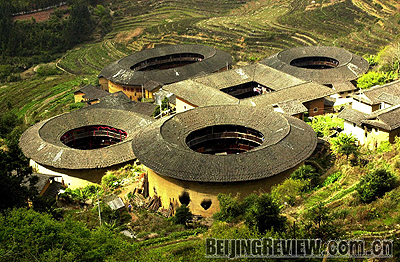|
Apart from the function of defense, the Tulou structure can withstand earthquakes and fire, and has good ventilation and lighting. Also, because the walls are very thick, around 1.5 meters on average, the temperature inside the house is moderate, making it warm in winter and cool in summer.
The Tulou architecture reflects the folk customs and the unique living style of the Hakka ethnic minority. The professional evaluation institution of the World Heritage Committee praised the Tulou's exquisite style as well as their durable and ingenious structure, saying they present a unique charm and outstanding universal value.
The Sanqingshan Mountain

LIVING WITH NATURE: A group of Tulou houses in Nanjing County, Fujian Province. These unique earth houses of the Hakka people can hold up to 800 families each
Located in the northeast of central China's Jiangxi Province, the Sanqingshan Mountain was included as a world heritage site for its exceptional scenic quality, prompting the World Heritage Committee to describe it as a natural copy of a Chinese landscape wash painting.
Covering an area of 22,950 hectares, the scenic zone of the Sanqingshan Mountain presents unique granite peaks and pillars featuring a variety of unusual shapes, rich vegetation and ever-changing weather patterns.
Because access to the mountain is difficult, the Sanqingshan Mountain is not that well known. It is only now after receiving world heritage status that visitors are beginning to take notice.
During the long process of geologic changes of the Earth, this area has miraculously remained intact and is believed by experts to be one of the best places to research the history of the planet and the activities of ancient tectonic plates.
Resembling human or animal silhouettes, the granite hills in the scenic area are a natural museum of granite features. One of the most spectacular scenes on the mountain is a huge cuboid granite pillar, which resembles a giant python.
The Sanqingshan Mountain has also been a holy place for Taoists for around 1,500 years. On route to the summit, some 200 Taoist temples or pavilions can be found.
The scenic area is also famous for the combination of subtropical monsoonal and maritime climates, which forms an island of temperate forest above the surrounding subtropical landscape. Besides the forests, it also features numerous waterfalls, some 60 meters high, clear lakes and springs.
With new road access, it has now become more convenient to reach the mountain. Currently, it takes three and a half hours drive from Shanghai to Shangrao, the city where the mountain is located. The distance from the Shangrao City to the scenic spot is around 80 km. | 